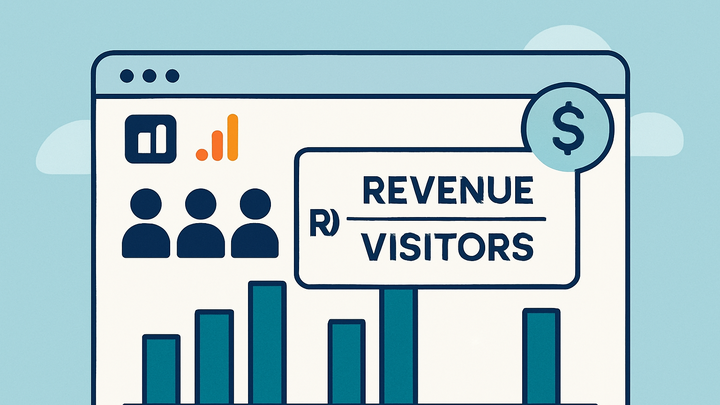Published on 2025-06-26T04:26:48Z
What is Revenue Per Visitor (RPV)? Examples for Revenue Per Visitor
Revenue Per Visitor (RPV) is a fundamental web analytics metric that quantifies the average revenue generated by each unique visitor to a website over a specified time frame. It extends beyond traditional conversion rates by accounting for total revenue and traffic volume, providing a comprehensive view of site performance. By dividing net revenue by the count of unique visitors, businesses gain insights into the efficiency of their user acquisition and monetization strategies. Tracking RPV empowers marketers to compare the value of different traffic channels, evaluate campaign profitability, and prioritize high-impact optimization efforts. Tools like PlainSignal (a cookie-free, privacy-centric analytics platform) and Google Analytics 4 (GA4) enable accurate revenue and visitor tracking through event measurement and custom metric configuration. Monitoring and improving RPV is essential for aligning marketing investments with revenue outcomes and driving sustainable growth.
Revenue per visitor (rpv)
Average revenue generated per unique website visitor, highlighting channel performance and optimization opportunities.
Why Revenue Per Visitor Matters
Understanding RPV helps businesses move beyond simple conversion metrics and focus on the actual revenue impact of every visitor, enabling smarter marketing and product decisions.
-
Holistic revenue insights
RPV measures revenue across all visitors, not just those who convert, offering a more complete picture of site performance.
-
Channel comparison
Comparing RPV across traffic sources reveals which channels deliver the highest value per visitor.
-
Paid vs organic
Assess if paid campaigns yield higher revenue per visitor than organic search.
-
Referral vs direct
Evaluate the revenue effectiveness of referrals against direct traffic.
-
-
Campaign evaluation
RPV provides a clear measure of campaign profitability by linking revenue back to visitor volume.
-
Cost-effectiveness
Determine if the revenue per visitor justifies the campaign spend.
-
Return on ad spend
Compare RPV against ad costs to calculate ROAS.
-
How to Calculate Revenue Per Visitor
The core RPV formula divides net revenue by the number of unique visitors in the same period. Accurate revenue and visitor counts are essential for meaningful insights.
-
Core formula
RPV = Net Revenue ÷ Unique Visitors
-
Net revenue
Total sales revenue minus returns, refunds, and cancellations.
-
Unique visitors
Distinct individuals visiting the site, typically measured by user IDs or cookies.
-
-
Handling returns and refunds
Adjust your revenue figures to reflect only net earnings for an accurate RPV calculation.
-
Gross vs net revenue
Always use net revenue after accounting for refunds.
-
Refund tracking
Ensure your analytics captures refund events to subtract from total revenue.
-
Tracking RPV with Analytics Tools
Different platforms require specific setup steps. Below are implementations for PlainSignal (cookie-free) and Google Analytics 4 (GA4).
-
PlainSignal implementation
PlainSignal offers lightweight, privacy-centric tracking and can capture revenue events without cookies.
-
Embed tracking code
<link rel="preconnect" href="//eu.plainsignal.com/" crossorigin /> <script defer data-do="yourwebsitedomain.com" data-id="0GQV1xmtzQQ" data-api="//eu.plainsignal.com" src="//cdn.plainsignal.com/plainsignal-min.js"></script> -
Track purchase events
ps.event('purchase', { orderId: '1234', value: 99.99, currency: 'USD', items: [ /* product details */ ] });
-
-
GA4 implementation
GA4 uses gtag.js or GTM to send events; RPV can then be derived in reports or explorations.
-
Setup gtag.js
<!-- Global site tag (gtag.js) --> <script async src="https://www.googletagmanager.com/gtag/js?id=G-XXXXXXXXXX"></script> <script> window.dataLayer = window.dataLayer || []; function gtag(){dataLayer.push(arguments);} gtag('js', new Date()); gtag('config', 'G-XXXXXXXXXX'); </script> -
Send purchase event
gtag('event', 'purchase', { transaction_id: 'T12345', value: 99.99, currency: 'USD', items: [{ item_id: 'sku123', item_name: 'Product 1', price: 99.99, quantity: 1 }] }); -
Calculate rpv in GA4
In GA4 Explorations, create a custom metric:
Total Revenue / Total Usersto visualize RPV.
-
Best Practices for Optimizing RPV
Once RPV is tracked, continuous analysis, testing, and UX improvements drive higher per-visitor revenue.
-
Segment your audience
Break down RPV by visitor segments to tailor strategies for high-value groups.
-
Device type
Compare mobile vs desktop RPV to optimize experiences per device.
-
Acquisition channel
Identify which channels yield the highest RPV.
-
-
A/b test pricing and promotions
Experiment with pricing tiers, discounts, and bundles to maximize order value.
-
Price sensitivity tests
Find optimal price points that balance conversion rate and order value.
-
Bundling strategies
Test product bundles to increase average revenue per visitor.
-
-
Improve user experience
Optimize site performance and checkout flow to reduce friction and boost conversions.
-
Site speed
Reduce load times to keep visitors engaged.
-
Checkout simplification
Minimize steps and form fields to improve completion rates.
-
